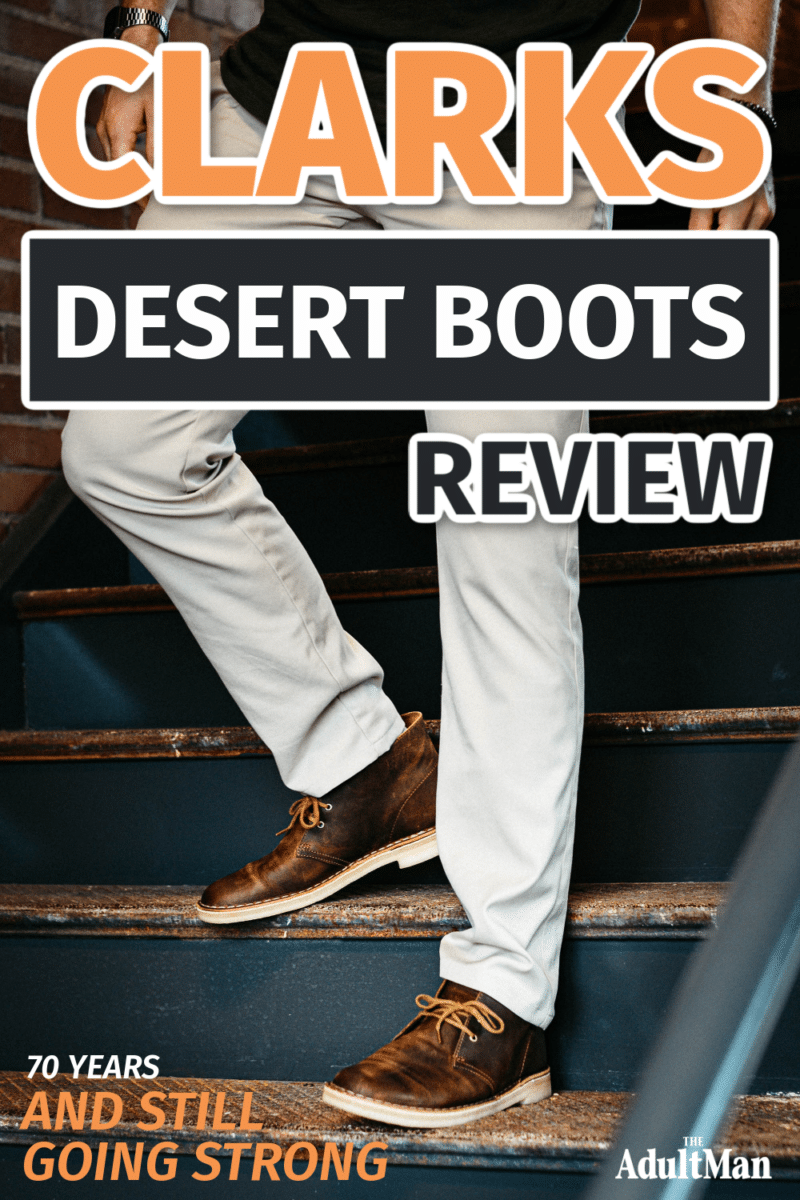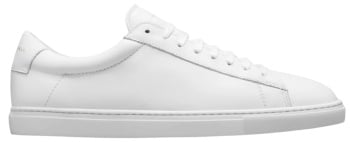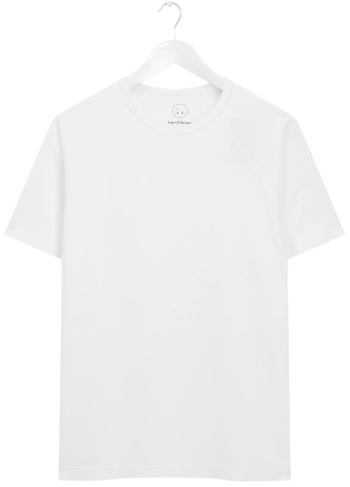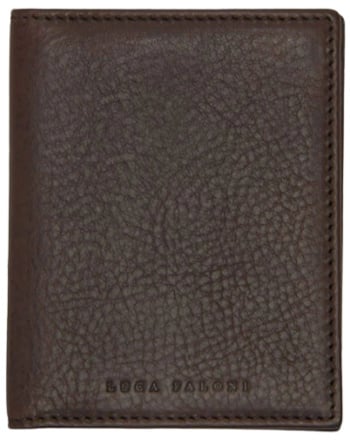That is, until I went to South Africa.
It seemed like every person in the entire country was wearing a pair of Desert boots. Even the giraffes.
When I came back home to the states, I kept seeing them everywhere—my eyes were opened, and I grew to appreciate the style.
Recently I picked up a pair to see what could be so special to keep the Clarks Desert Boot going strong for 70 years.
Skip Ahead
Since 1950

Yep, the Clarks Desert Boot first came out in 1950.
Nathan Clark was a fourth generation shoe-maker, and as British soldier stationed in Burma during WWII, he’d seen off-duty officers wearing a particular style of boot. The boots all came from a bazaar in Cairo, and before he returned home to England, he picked up a pair for himself.
Clarks has been around since the 1820s, but they became world-renown after Nathan Clark launched the Desert Boot in 1950.
Desert boots are now part of many folks’ casual wardrobe arsenal—they’re dressier than sneakers, but don’t make the cut for any tailored clothing.
You can spot if someone’s wearing a Clarks chukka if it has the iconic crepe sole (crepe is an unrefined, simple type of rubber).
Things to Consider Before Buying Clarks Desert Boots

You should only get a pair of Clarks Desert Boots if you plan on wearing them in casual settings. Though a lot of boots can pair with more dressy outfits (like Chelsea boots or Oxford boots), chukkas are firmly casual.
Clarks offers their chukkas in a wide range of leather-types, from beeswax infused, to suede, to nubuck and they pair well with jeans and chinos.
If you have flat feet, it may be better to look at another style of boot, as chukkas rarely have a shank in them. That, combined with the soft crepe rubber sole, can lead to discomfort down the road if you need lots of arch support.
Clarks Desert Boot Review
Unboxing

After opening up the box, a wave of that good fresh leather scent punched me in the face. I picked up the desert boot in Beeswax, which is a classic, matte brown leather—something similar to what Nathan Clark introduced to the world 70 years ago.
These boots are simple, which is part of their appeal.
The upper is made with just two pieces of leather, stitched together just above the instep. There are two eyelets for the shoestring, though these laces don’t really tighten the boot too much.

Desert boots wear almost like slippers, and I don’t even tie/untie them anymore—I just slip them on and off.
The upper is stitched right to the crepe sole which is a really simple, easy, and quick way to make shoes.
And that’s really the appeal of these boots. While they used to pass as somewhat formal back in the 50s, they’re now firmly in the casual category. The charm is in their versatility and simplicity.

I’m a fan of the beeswax leather—it feels like an homage to their military origin, and looks excellent with any of my olive chinos and blue jeans.
But if that matte, natural leather look isn’t your jam, Clarks offers 13 other colorways for the Desert Boot. The brand has several suede options, which look excellent, but I stayed away. To me, the suede loses its form too quickly and looks floppy. The matte leather is cleaner, and I love the patina that’s forming for my boots.
Leather

Leather is the star of the show here, and for the price, the quality is fantastic. While Clarks doesn’t say what level of quality their leather is, based on the grain I can see around the ankle and at the sole, my guess is that it’s the transition between top-grain and full-grain.

So it’s not quite the top-level quality, but it’s better than your average shoe leather.
The beeswax colorway uses a pull up leather, which is a characteristic of leathers that are richly saturated with waxes and oils.
So when the leather bends, you’ll notice it becomes lighter along the crease. This becomes prominent on the upper near the ball of your foot and at the instep. Basically, the oils have been pushed out of that portion of leather, leaving it lighter.

Just use your thumb and rub the lighter creased areas and the oils and waxes will melt back in and redistribute. This doesn’t say anything about the quality of the leather, other than that you won’t have to recondition it a lot.
For me, I’ll probably clean and recondition these every six-months unless they get caught in a rainstorm. They really don’t need a lot of care. That said, I’m leaving a pair of shoe trees in my Desert Boots because they tend to lose their shape fairly easily. There isn’t a lot you can do to fight this, but you can avoid total collapse with shoe trees.
Sole

While the leather is the star, the crepe sole is the supporting actor that makes Clarks Desert Boots so unique.
Crepe rubber is a coagulated latex, or in simpler terms: sap from the rubber tree is dried and rolled out in a way that is far-less processed than most rubber we’d find elsewhere.
There are some benefits and drawbacks to crepe soles.
On the positive side, they’re super soft, comfortable, distinctive, and have an excellent grip on the street and in sandy environments.
On the negative side, they discolor quickly, the material can chip out (especially around the heel), it wears down quicker than other rubber soles, and it doesn’t offer much slip resistance when the ground gets wet.

Some folks wear their Desert boots day in and day out (for instance, every single person in South Africa). I can’t see these soles holding up for more than a year and a half of every-day wear. And one downside to this shoe construction and crepe sole is that only a few cobblers will resole them for you once the crepe rubber is worn out.
So unlike a pair of service boots or work boots, the kind that can last 10-20 years if you resole them every few years, these Desert Boots have a more limited lifespan because of the crepe sole.
That said, it’s part of the distinctive look of Clarks. I’ve been wearing mine once or twice a week, so I should have mine for several years before the heel and sole get tired.
Comfort and Wearability

As someone with excellent arches, I’m very comfortable in these chukkas. Because the crepe sole is relatively unrefined, it’s soft and absorbs a lot of impact. The upper is pliable and the rough leather insides make for an easy break in. I didn’t have any rubbing or sore arches after wearing these around town, which is rarely the case with new boots.
But if you have flat feet and need arch support, you’ll definitely want to pick up an orthopedic insert for these.
There’s no shank in the boot and because the sole is so soft, there’s a lot of bend along the arch. If you have flat feet and no insert, most of the pressure from your footsteps will go to the front of your heel and likely cause some discomfort. With an insert though, it’s no problem.

And like I said, most folks don’t have flat feet. I don’t, and I found these to be very comfortable for walks through the city.
I wouldn’t take them on a hike or anything like that—the soft rubber on bottom means you can definitely feel any rocks underneath you. But for padding around on concrete, these have the comfort of sneakers, but they’re a little more upscale.
What do Other Reviewers Say?

Most reviewers on the Clarks site were happy with their Desert Boots. Ironically, the most common reason for absolutely loving Clarks was also the number one complaint: comfort.
Nearly every negative review I read mentioned a “difficult break in period.” As I mentioned earlier, this is likely due to flat feet. The leather upper is soft and stretches quickly, so I can’t imagine the upper being the problem.
What’s far more likely is that the lack of a shank and the pliability of the sole puts pressure on the heel and instep for folks with flat feet.
If you’re not sure whether you have flat feet try this: after you get out of the shower next, wait until your foot is mostly dry, but still has some moisture on the bottom, and step onto either a brown paper bag or something else that will mark your wet foot print.
If you can see the entire bottom of your foot, you might have flat feet. If you have solid arches, you’ll see your toes, the ball of your foot, the outside portion of your foot, and your heel.
You can still wear Clarks Desert Boots comfortably even if you have flat feet—I recommend getting an orthopedic insert. Really, that recommendation isn’t just for these chukkas—it’s for every type of shoe you own.
Besides that one complaint, most reviewers enjoyed how comfortable they are and their classic style. Folks seemed as impressed with the leather quality as I was, too.
My Thoughts Overall On Clarks Desert Boot
What I Like
They’re made with high-quality leather (somewhere between top grain and full grain) rich with oils so it’s fairly weather-resistant and doesn’t need regular conditioning.
Pull-up leather lends a nice patina and makes the shoes look “worn-in” only after a few days.
Crepe rubber sole is among the softest soles you can find—these boots are cushy. They’re also silent—great for ninjas.
The 60-day return policy is very generous and free shipping and returns makes ordering online a safe and easy bet.
What I Don’t Like
There’s no shank in the boot, which can lead to some discomfort in the heel until the boot has broken in fully.
Crepe soles aren’t very easy to resole, so you may not be able to repair these once they’ve worn down.
Who is the Desert Boot for?
The Clarks Desert Boot is an excellent choice for anyone looking to pick up an iconic look that brings more class to a casual wardrobe than a pair of sneakers. These chukkas are definitely casual, but the smooth look of patinated leather (or suede) can make elevate even simple outfits like a t-shirt and jeans.
The Verdict
Clarks Desert Boots are classic and iconic—how many other shoe lines can claim they’ve been going for 70 years strong?
After trying them, I can see why they’ve been so popular for so long.
Made with rich pull up leather, your new boots will develop a beautiful, worn-in look that styles well with raw denim and chinos (some say you can wear them with shorts—I disagree).
Desert boots have their drawbacks, mainly regarding the crepe sole. This sole is distinctive, and few brands use it. On the plus side, crepe soles are very soft and offer tons of padding for your feet. But once they’ve worn out, there’s not much you can do for your shoes.
Shoe repair shops might take a chance at resoling these Desert boots, but it’s a much harder task than resoling goodyear welted shoes.
The sole durability issues can be tempered by wearing them only a few times a week. If you do that (like I’ll be), these Clarks should last several years. If you want something to wear every single day of the week, look at the Clarks Bushacre—same cut, but with a synthetic sole.
The Desert boot features excellent quality leather, making the price more than fair. The style is versatile, too, so I’m happy wearing these for the rest of summer and into fall/winter.
After 70 years, it’s great to see that Clarks is sticking to the classics.
The Clarks Desert Boot is over 70 years old. It wouldn't last that long if there wasn't something special about it.
FAQs
Are Clarks Desert Boots comfortable?
Yes, Clarks Desert Boots are comfortable. For those with flat feet: because there’s no shank in this boot, add an orthopedic insert. If you have solid arches, these will feel comfortable right away.
Are Clarks Desert Boots worth it?
Absolutely. There are few brands that use this quality of leather in their boots for a similar price point.
Do Clarks Desert Boots break in?
Yes, Clarks Desert Boots break in, but the period is very short (or non-existent). The leather is soft and pliable, so you shouldn’t feel any uncomfortable rubbing. The break in will mostly be felt in the heel.
How long do Clarks Desert Boots last?
If you wear your Clarks Desert Boots every day, they’ll likely last about a year and a half. If you give them a rest throughout the week and wear them only once or twice, they should last three to four years.










